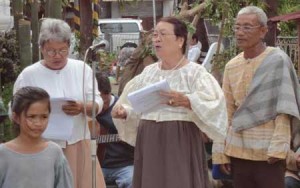Professor Luspo of Holy Name University observed that dayegon used to start with acknowledgment and greeting to the homeowners. This is then followed by the adoration song and dance, performed with the singers intently looking at the Baby Jesus. Then it culminates with a farewell routine in which the manaygonays bade farewell to the Holy Family and the “Tagbalay nga Bulahan” (Household Owners).” Interestingly, this is the same sequence followed by the Balitaw, the ancient art of love joust set to music and which is one beloved art form among Bisayans,” he noted.
The cultural researcher said that “while these songs were taught amidst the dominant backdrop of Western colonization, there was no wholesale importation of tradition here.
Coming from the native peasantry, the dayegons reflect an insistence at localizing or contextualizing the faith they received from a foreign source.”
“This makes the dayegon a valid expression of Filipino culture,” he adds.
In terms of musical treatment, he observed that “the dayegons were originally set to the pastorella time signature, i.e + with emphasis on the downward beat. Again this is indicative of European origin. The dayegons that came out during the late 1920’s are recognizable because of their heavily syncopated beats. The history of 20th century music bears this out.”
He contended that “the Jazz Age brought about not just a new liveliness to the traditional dayegons, it also marked the commercialization of the genre and led to its present-day degeneration.”
Luspo clarified that “the original dayegon was . . . intended as a devotional practice, allowing ordinary folks to concretize their joy over an important article of the Catholic faith. The going from house to house was aimed primarily at making repeated adorations to the Christ Child, a form of prayer. This means it was never done with the intention of soliciting goods from householders. If the homeowner, grateful for the visit, offered refreshments or token money, it was not the manaygonay’s intention.”
In the evolution of the new form of dayegon, “it was not anymore imperative for the manaygonays to perform before the Belen. In fact, the object of the performance was now to please the Tagbalay nga Bulahan (the Lucky Homeowner) – as a source of favors. The dayegon has slowly become an outside-the-window performance, a yuletide serenade.”
In Luspo’s view, “this caused the eventual diminution of the traditional Belens of Bohol.
While before there was a need to appropriate one half of the sala to cater to walk-in devotees, the new Belens became simpler table installations set in one corner of a vast living room.”


